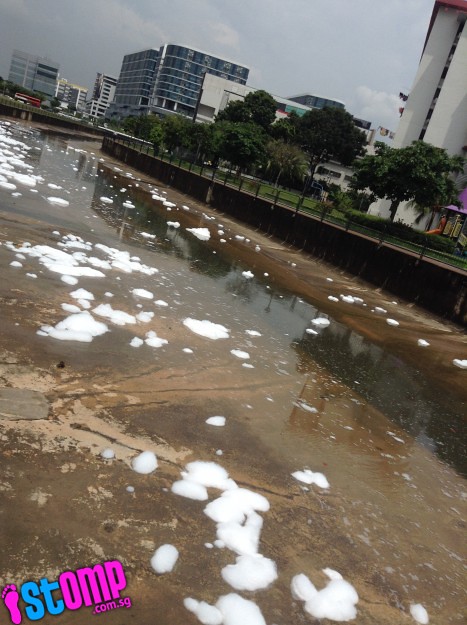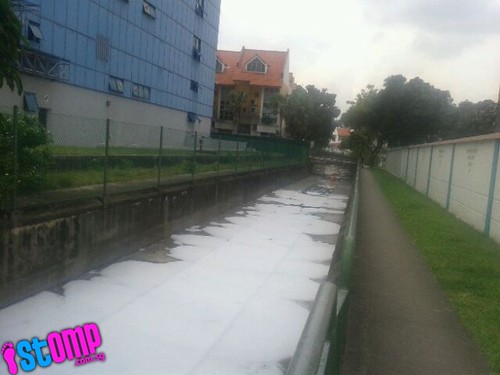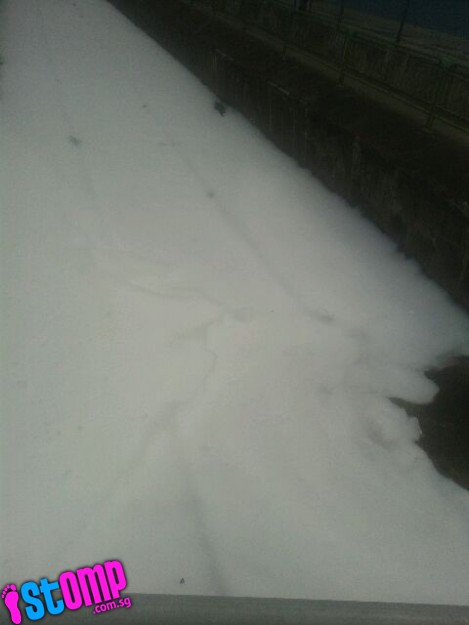
STOMPer Lisa was concerned to see the water in a Sungei Kallang drain turn white at about 2pm today (Oct 19).
The STOMPer also saw two workers doing construction work nearby, and wondered if that had something to due with the residue in the drain.
Lisa elaborates:
"Soon after lunch today at about 2pm, I noticed quite a lot of suds floating down Sungei Kallang near Circuit and Balam Road.
"I was concerned as this is not the first time I had seen this.
"The suds ended at a drain adjacent to Little Road , next to 13 Little Road and leading to a private residential estate.
"I saw a worker working on something that looked like cement a little distance from where the suds ended and another worker working on the same thing further upstream.
"There were some sand on the walkway and road work cones next to the drain.
"I just wonder where these suds come from and whether these workers have anything to do with these suds.
"I am concerned about the impact of such pollution on our drinking water and whether strict measures are enforced to ensure the cleanliness of our drinking water."



This looks bad, especially considering that the Kallang River drains into Marina Reservoir. I hope the Public Utilities Board (PUB) and National Environment Agency (NEA) were notified about this.
Under Chapter 94A of the Environmental Protection and Management Act, Section 17 states:
(1) Any person who discharges or causes or permits to be discharged any toxic substance or hazardous substance into any inland water so as to be likely to cause pollution of the environment shall be guilty of an offence and shall —
(a) be liable on the first conviction to a fine not exceeding $50,000 or to imprisonment for a term not exceeding 12 months or to both; and
(b) be punished on a second or subsequent conviction with both imprisonment for a term of not less than one month and not more than 12 months and a fine not exceeding $100,000.
(2) Where a person carrying on any trade or business has been convicted of a second or subsequent offence under subsection (1)(b) for the discharge of, or for causing or permitting the discharge of, any toxic substance or hazardous substance which is produced by any process or work in connection with that trade or business, the Agency may, by order in writing, direct that person to immediately cease carrying on that process or work either indefinitely or for such period as may be specified in the order.
[4/2002]
(3) Any person who fails to comply with an order made under subsection (2) shall be guilty of an offence and shall be liable on conviction to a fine not exceeding $100,000 or to imprisonment for a term not exceeding 3 months or to both and, in the case of a continuing offence, to a further fine not exceeding $2,000 for every day or part thereof during which the offence continues after conviction.
(4) If any person fails to comply with an order made under subsection (2), the Director-General may take such step or measure as is necessary to ensure that the order is complied with and the reasonable costs and expenses incurred by the Director-General in taking such step or measure shall be recoverable from the person in default as a debt due to the Agency.
[4/2002]
(5) For the purposes of this section —
(a) a person shall be deemed to have discharged a toxic substance or hazardous substance into any inland water if he places the substance or causes it to be placed in a position where it is liable to fall or descend or be washed or to percolate or be blown into the water;
(b) the discharge of a toxic substance or hazardous substance shall be deemed to cause pollution of the environment if the substance has been discharged or placed in such a manner or in such quantity (whether by itself or with any other substance) as to subject persons or animals to a material risk of death, injury or impairment of health or as to threaten to pollute (whether on the surface or underground) any inland water;
(c) the fact that the toxic substance or hazardous substance is placed in containers shall not of itself be taken to exclude any pollution of the environment which might be expected to be caused if the substance were not in containers; and
(d)where the toxic substance or hazardous substance has been discharged from any premises into any inland water, it shall be presumed, until the contrary is proved, that the occupier of the premises, other than a principal contractor to which section 35 applies, had discharged or caused or permitted to be discharged the toxic substance or hazardous substance in contravention of subsection (1).